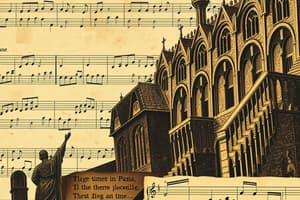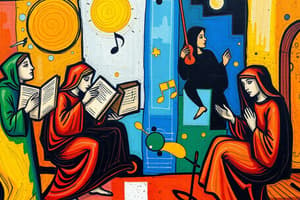Podcast
Questions and Answers
What is monophonic plainchant named after?
What is monophonic plainchant named after?
- Pope Leo X
- Pope John II
- Pope Benedict XVI
- Pope Gregory I (correct)
Sacred music is intended for non-religious audiences.
Sacred music is intended for non-religious audiences.
False (B)
What is a Troubadour?
What is a Troubadour?
A group of musicians that performed secular music across Europe.
The Renaissance period means '_____.
The Renaissance period means '_____.
Name one characteristic of Gregorian chants.
Name one characteristic of Gregorian chants.
Which of the following composers is known as the Greatest Master of the Roman Catholic Church during the Renaissance period?
Which of the following composers is known as the Greatest Master of the Roman Catholic Church during the Renaissance period?
A madrigal is a secular vocal _____ composition that originated from Italy.
A madrigal is a secular vocal _____ composition that originated from Italy.
What is the dominant instrument of the Renaissance era?
What is the dominant instrument of the Renaissance era?
What was Adam de la Halle known for?
What was Adam de la Halle known for?
Match the following sections of Mass with their descriptions:
Match the following sections of Mass with their descriptions:
Flashcards are hidden until you start studying
Study Notes
Medieval Period
- Spans the Middle Ages (also known as the Dark Ages).
- The Christian Church significantly influenced European culture and politics.
- Monophonic plainchant, notably Gregorian chant, named after Pope Gregory I.
- Pope Gregory I popularized monophonic plainchant, initially transmitted orally.
- Scholars later notated chants to facilitate their spread across Europe.
Characteristics of Gregorian Chants
- Monophonic texture: single melodic line.
- Free meter: not fixed to a strict rhythm.
- Modal: based on modes rather than major/minor scales.
- Primarily rooted in Latin liturgy.
- Utilized neume notation for written representation.
Sacred vs. Secular Music
- Sacred music is considered holy and created for religious contexts, predominantly the church.
- Secular music is intended for a non-religious audience.
- Troubadours were musicians performing secular music across Europe.
Troubadour Music
- Typically monophonic with occasional improvised accompaniment.
- Themes of chivalry and romantic love.
- Originated in France and composed in the French language.
Famous Composer of the Medieval Period
- Adam de la Halle (also known as Adam le Bossu) was destined for the church but eventually married.
- Known for "Le Jeu de Robin et de Marion," the earliest surviving secular French play with music.
- Other works include "La Chanson du roi de 12 Sicile."
- His contributions include chansons and poetic debates.
Renaissance Period (1400-1600)
- The term "Renaissance" means "rebirth," reflecting a revival of interest in ancient Greece and Rome.
- The invention of printing in the 1400s allowed for broader distribution of Renaissance music.
- Increased popularity of music as entertainment among amateurs and the educated populace.
- Secular music gained prominence; recognized as the golden age of a cappella choral music.
- The lute emerged as the leading instrument during the Renaissance era.
Vocal Music of the Renaissance Period
Mass
- A sacred musical composition setting texts of the Eucharistic liturgy to music.
- Main sections of the Mass are Kyrie, Gloria, Credo, Sanctus and Benedictus, and Agnus Dei.
Madrigal
- A secular vocal polyphonic music form originating from Italy.
- Performed during courtly social gatherings; considered the most important secular form of the Renaissance.
- Characteristics include polyphonic texture, a cappella performance, and 3-6 vocal parts.
Famous Composers of the Renaissance
-
Giovanni Pierluigi da Palestrina is regarded as the greatest master of the Roman Catholic Church music during the Renaissance.
-
Majority of Palestrina’s works are sacred music, aligning with church aspirations.
-
Served as organist and choir master at significant churches like Sistine Chapel and St. Peter’s Basilica.
-
His first published book, "MASS," was highly appreciated by Pope Julius III.
-
Thomas Morley hailed from Norwich, England, and began singing in the local cathedral.
-
Became the master of choristers at age 26 and was the prominent composer of secular music during his time.
-
Studied under William Byrd and earned a Bachelor’s Degree at Oxford.
-
Later became an organist at St. Paul's Cathedral and published collections of madrigals.
Studying That Suits You
Use AI to generate personalized quizzes and flashcards to suit your learning preferences.




